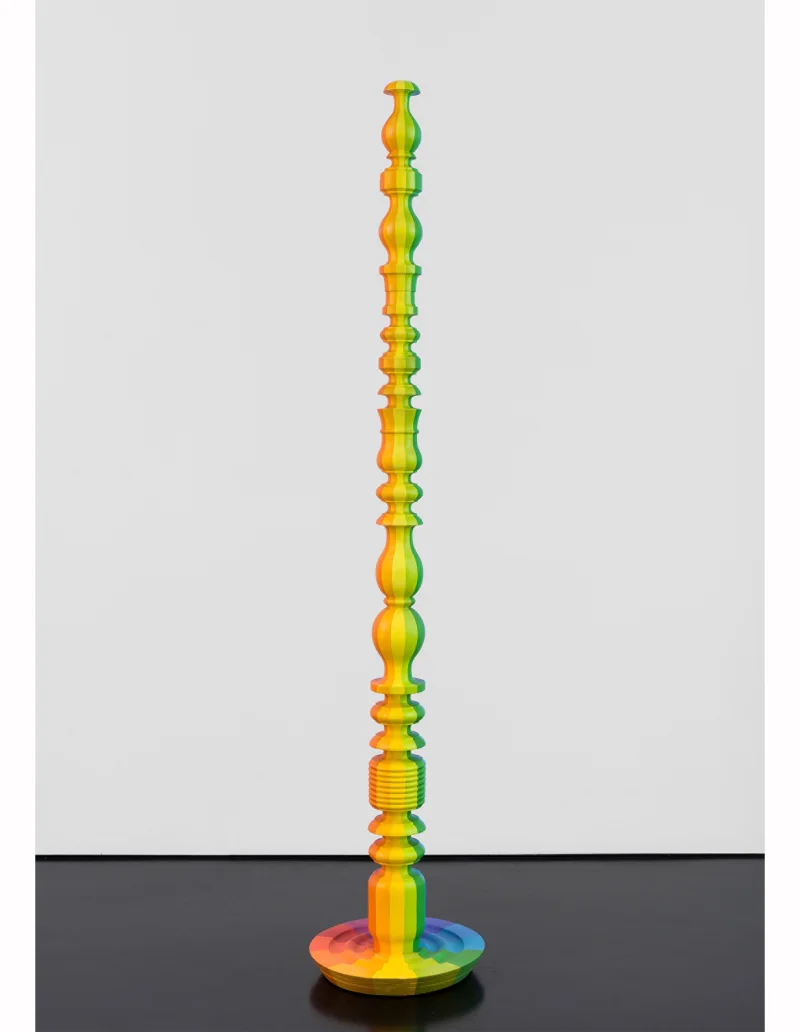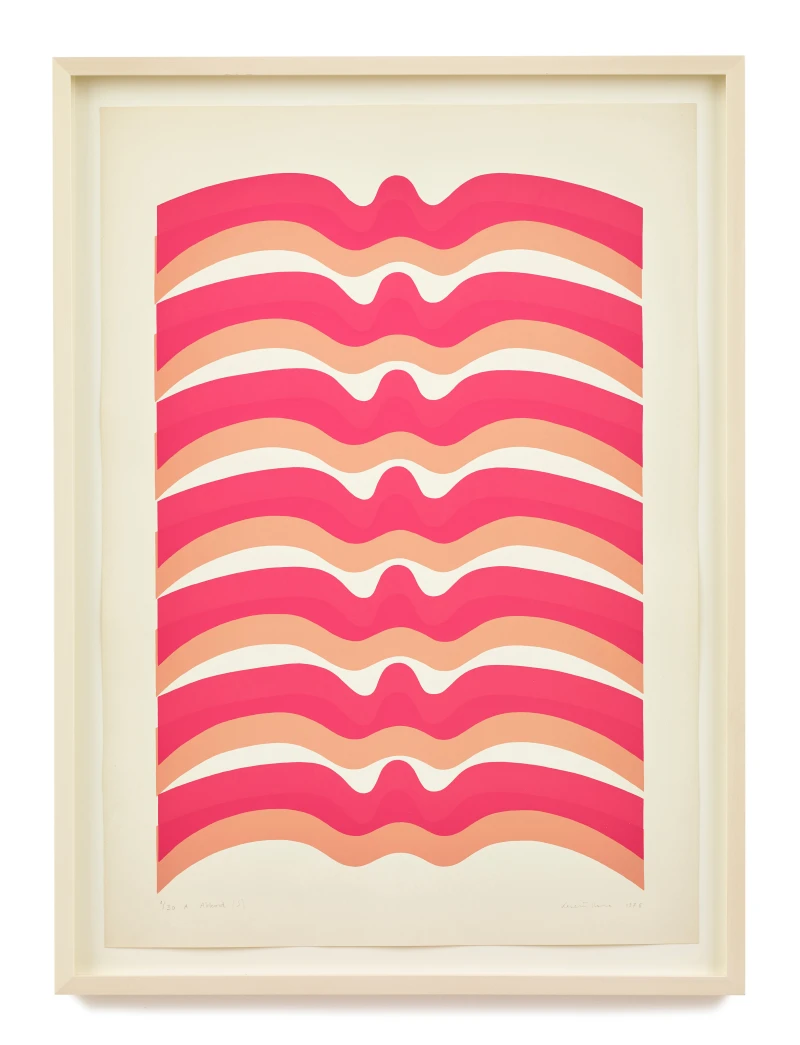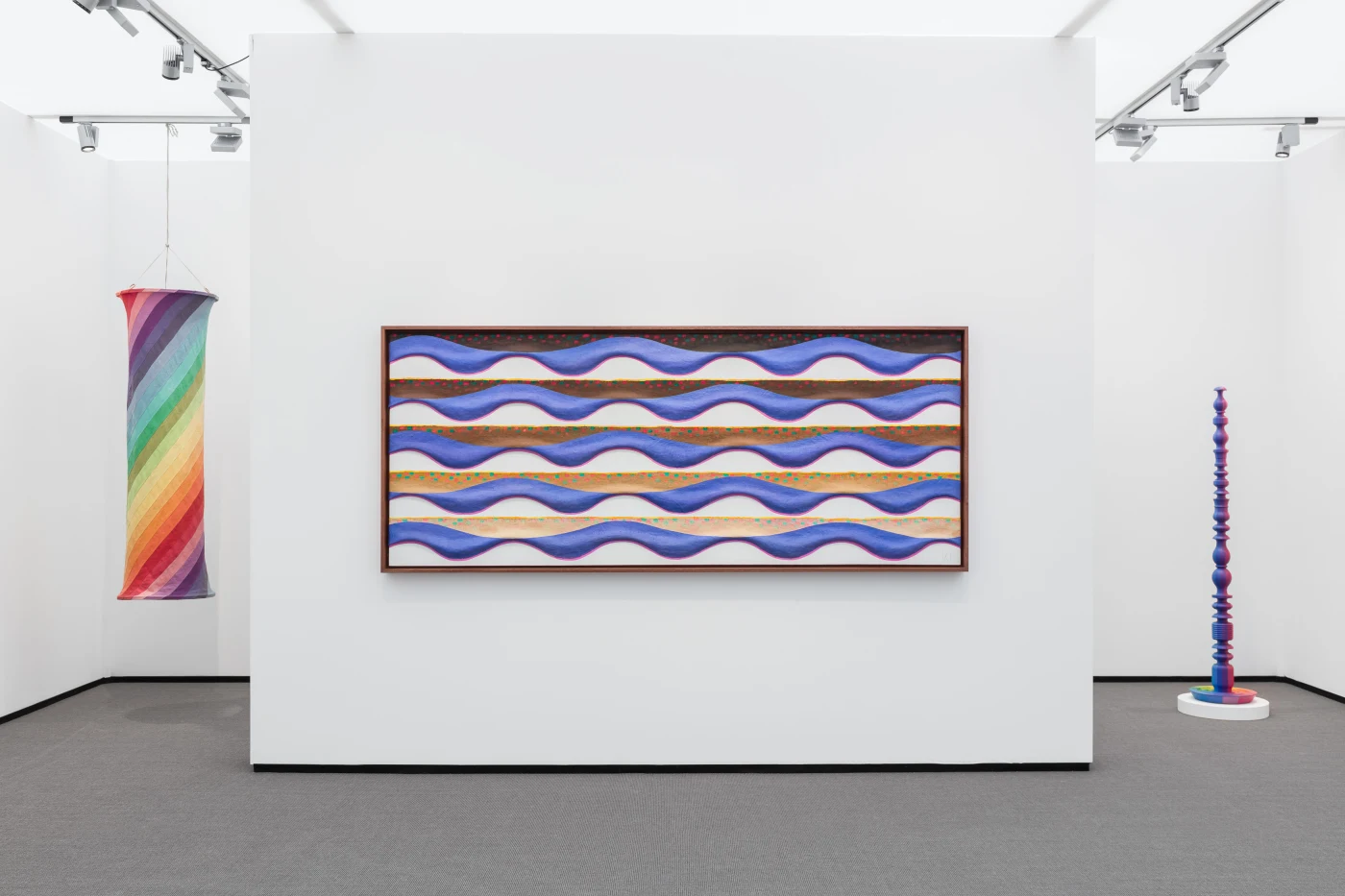
Frieze Masters
Overview
Stephen Friedman Gallery presents Ilona Keserü for Frieze Masters 2022. This exhibition focuses on works from the 1970s and early 1980s and demonstrates the breadth of her practice, spanning multiple disciplines including painting, sculpture and work on paper.
Keserü’s distinctive approach combines references to Hungarian folk culture with Western European modern art and historic architecture. The artist’s organic abstract style developed in defiance of Soviet rule following the Hungarian revolution of 1956. Her liberal use of forms and bold palette expressed a refusal to conform and an affinity with ideals beyond the Iron Curtain.
One year spent in Italy in 1963 led to Keserü becoming influenced by the local architecture, with baroque forms subsequently incorporated into her practice. In the late sixties, the artist undertook an intense period of experimentation, conducting what she refers to as ‘colour research’. In many works, swathes of luminous paint form meandering shapes alongside erratic gestural brushstrokes. The corporeal qualities of her curvilinear forms are animated by vibrant, expressive use of colour. Heart-shaped headstones discovered at a cemetery in Balatonudvari in Hungary came to inspire the lobed motifs in paintings for years to come.
Stephen Friedman Gallery presents Ilona Keserü for Frieze Masters 2022. With a career extending over seventy years, Keserü is one of Hungary’s leading post-war abstract artists. This exhibition focuses on works from the 1970s and early 1980s and demonstrates the breadth of her practice, spanning multiple disciplines including painting, sculpture and work on paper.
Keserü’s distinctive approach combines references to Hungarian folk culture with Western European modern art and historic architecture. The artist’s organic abstract style developed in defiance of Soviet rule following the Hungarian revolution of 1956. Her liberal use of forms and bold palette expressed a refusal to conform and an affinity with ideals beyond the Iron Curtain.
One year spent in Italy in 1963 led to Keserü becoming influenced by the local architecture, with baroque forms subsequently incorporated into her practice. In the late sixties, the artist undertook an intense period of experimentation, conducting what she refers to as ‘colour research’. In many works, swathes of luminous paint form meandering shapes alongside erratic gestural brushstrokes. The corporeal qualities of her curvilinear forms are animated by vibrant, expressive use of colour. Heart-shaped headstones discovered at a cemetery in Balatonudvari in Hungary came to inspire the lobed motifs in paintings for years to come.
Following a pivotal visit to Western Europe in the early 1970s, Keserü proclaimed, “I’ve decided that I must do what I want, and I must do it in Hungary.” From free-flowing curves in her works on paper to rainbow-coloured sculptures, the exhibition demonstrates the playful aspects of Keserü’s practice. Highlights include ‘Cylinder Robe’, 1978 a theatrical installation made from linen. Gallery visitors were originally invited to ‘wear’ the structure, which would ascend and drop via a pulley operated by an assistant. The installation recalls her work on scene and costume design (1967–76), blending these disciplines with sculpture. Activated by physical presence, the work speaks to Keserü’s focus on her audience in a context of censorship and restrictions.
Thursday Preview 13 October - Saturday 15 October: 11am - 7pm
Sunday 16 October: 11am - 6pm
Installation Views

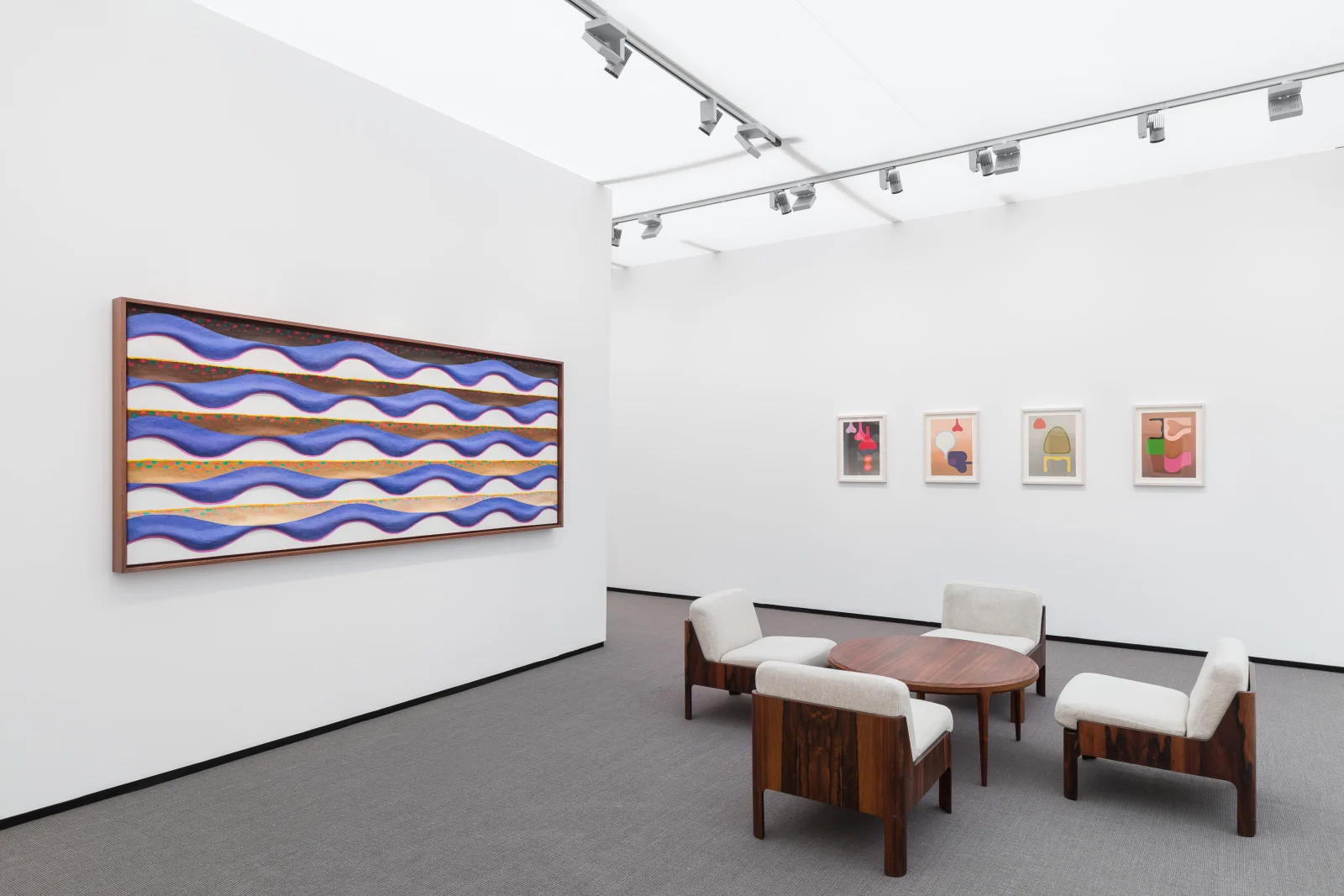
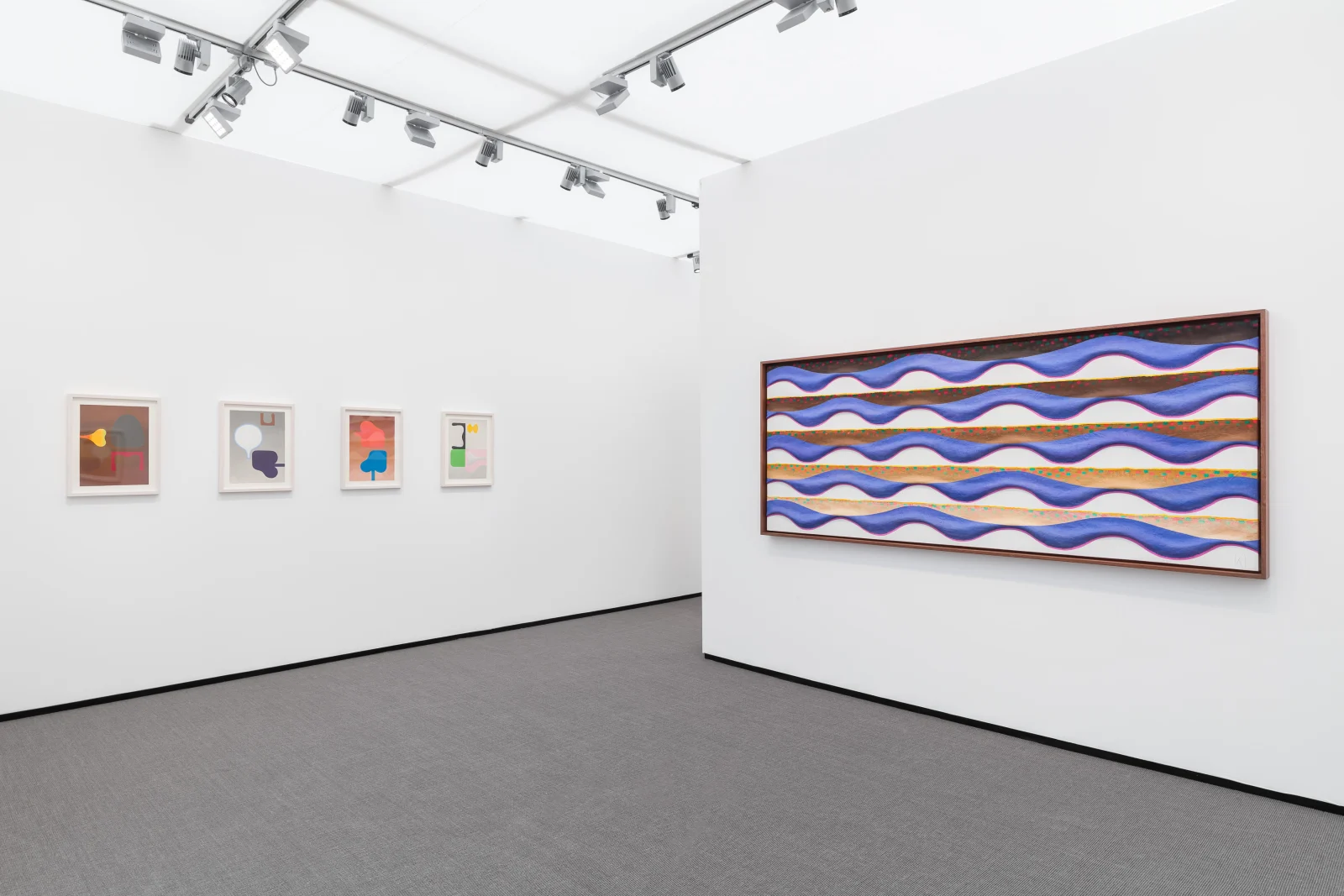


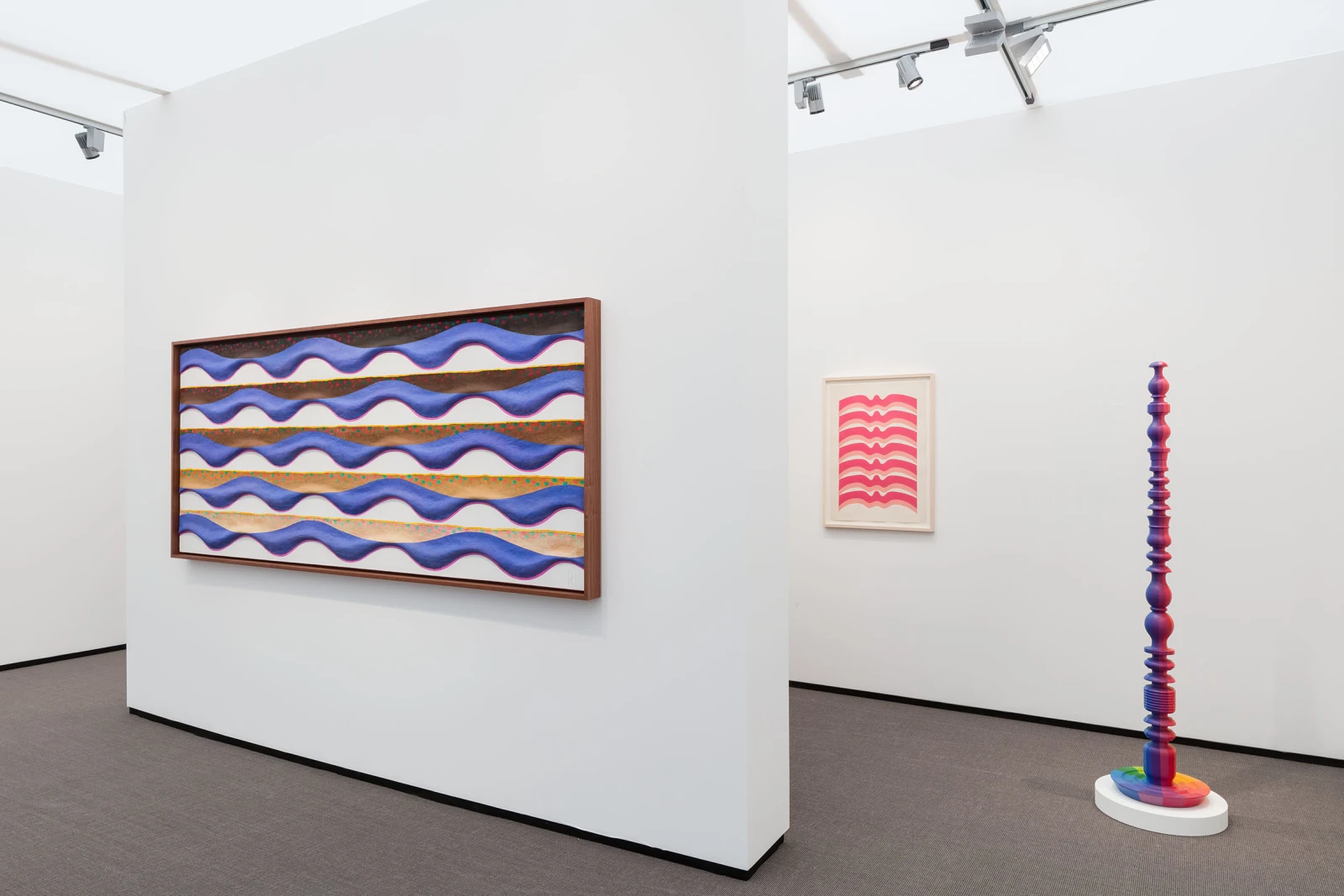

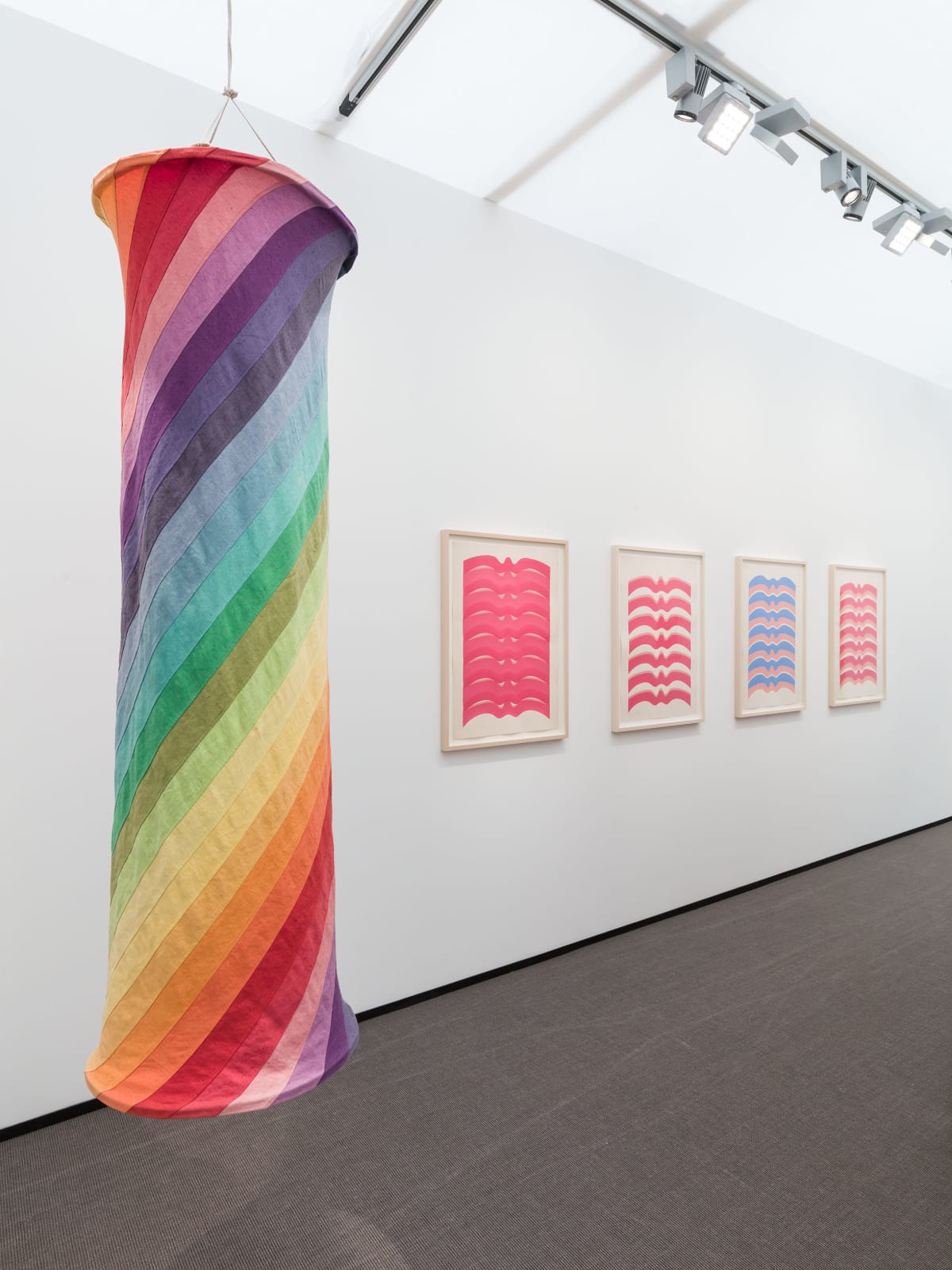
"The realisation that even today painting can be a great thing, chiming in with or anticipating the fundamental motions of the world, existence and the age; that even today personality, provided it is strong and determined and talented enough, can create omnipotent art. This strength, supported by and building on the knowledge of the ancients – though also separated from it by "personal brutality" – pierces through the period and leaves a valid trace."
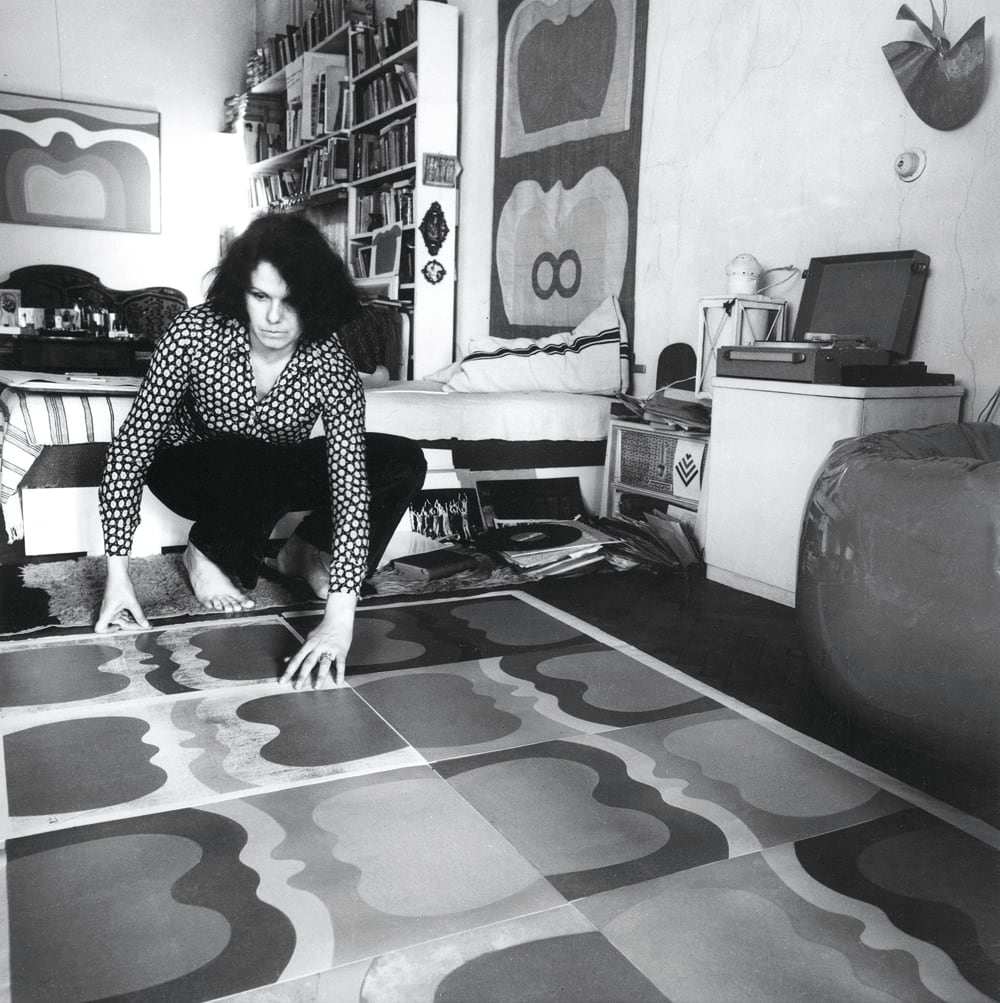
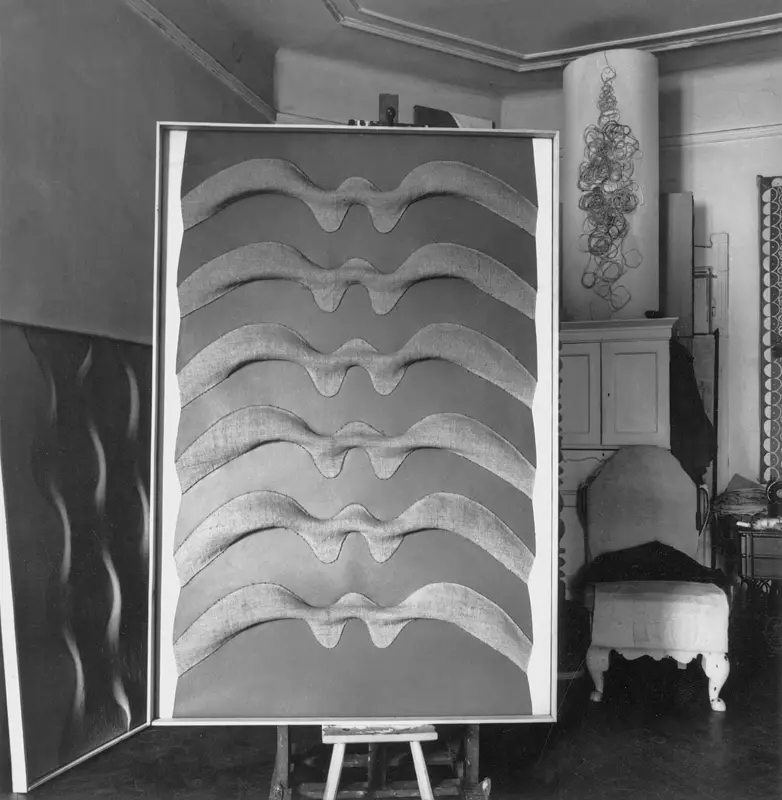
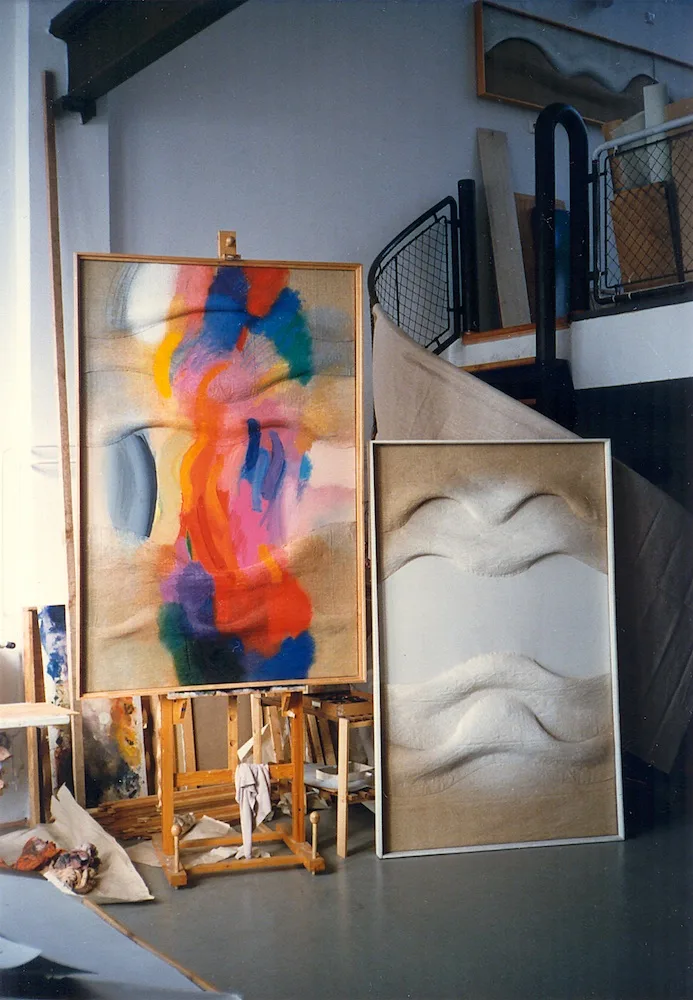
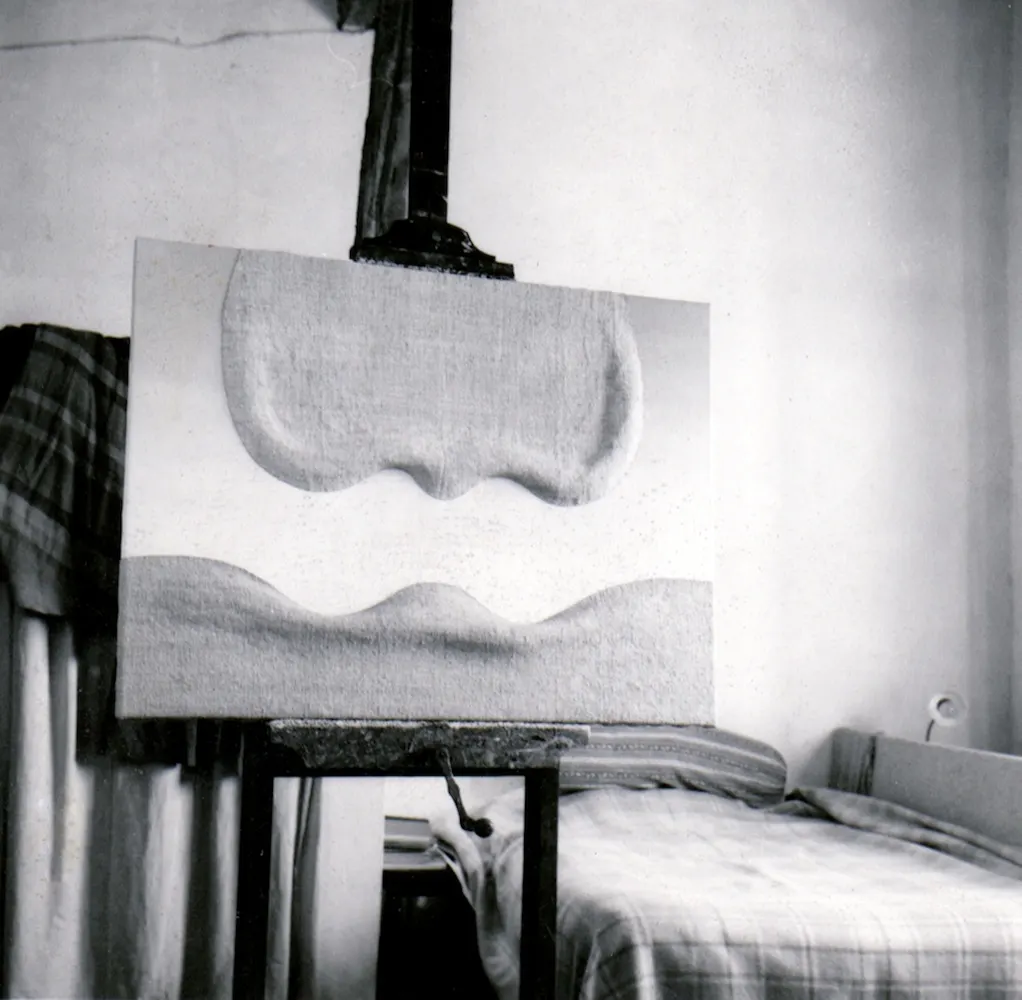

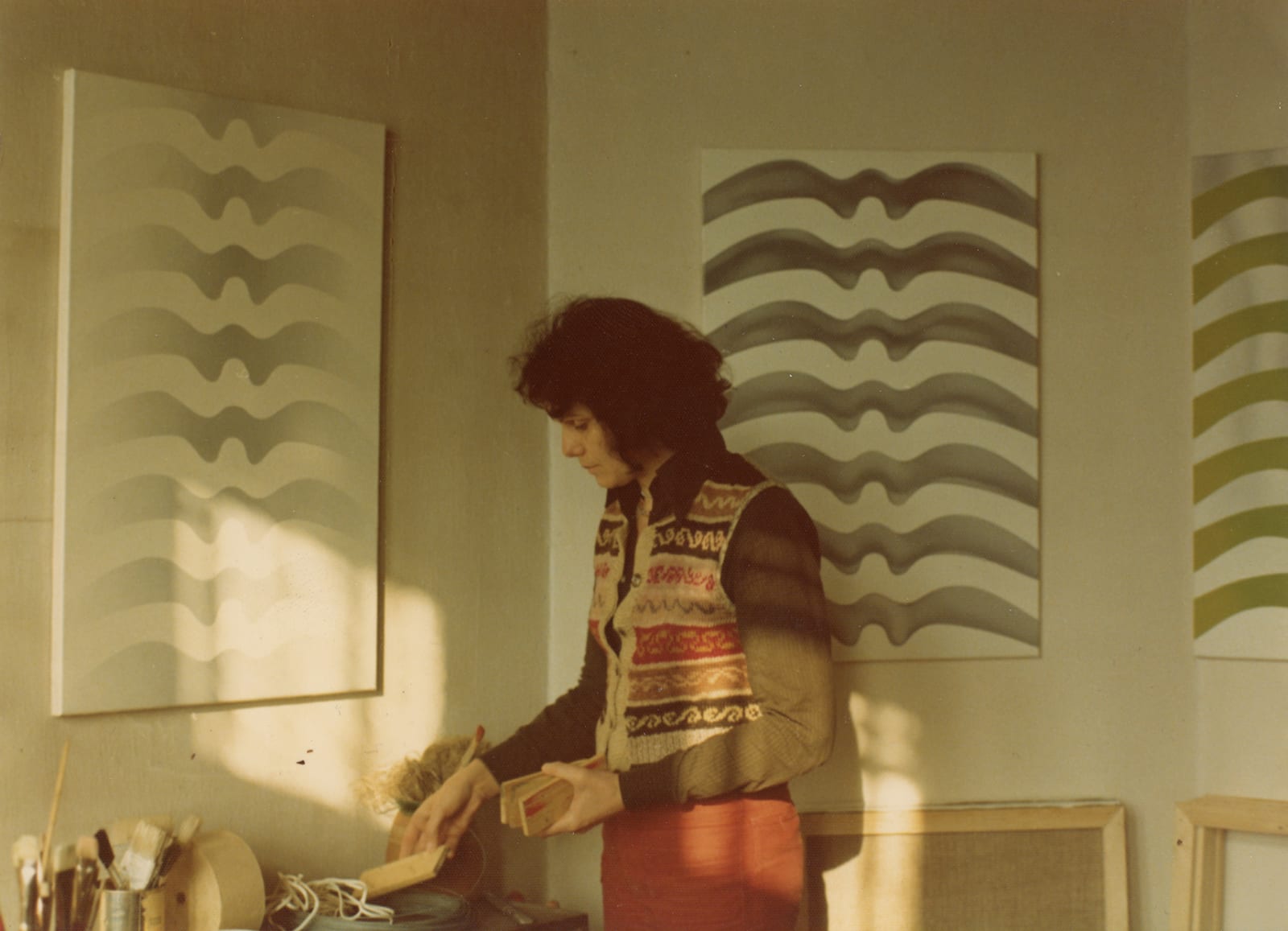
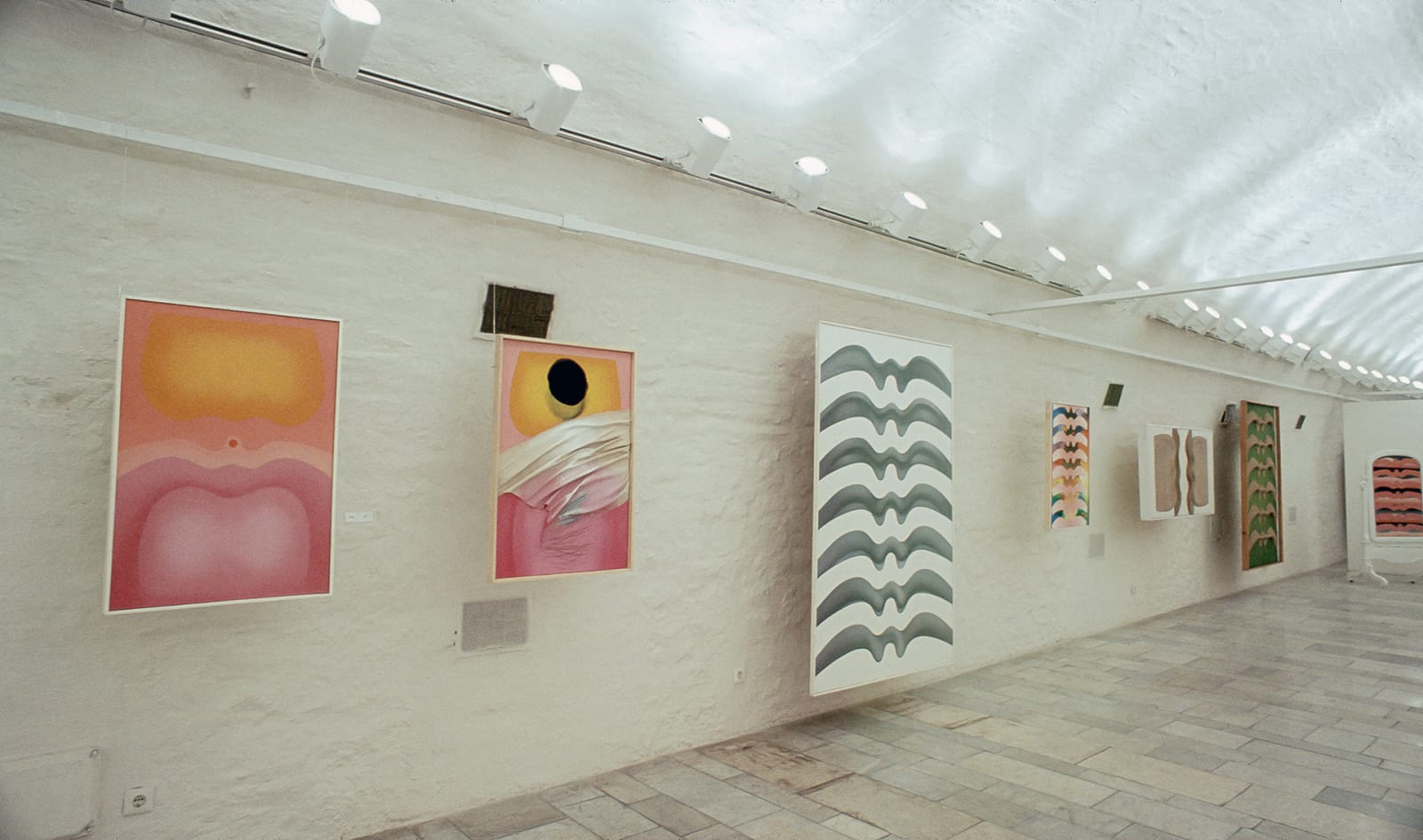
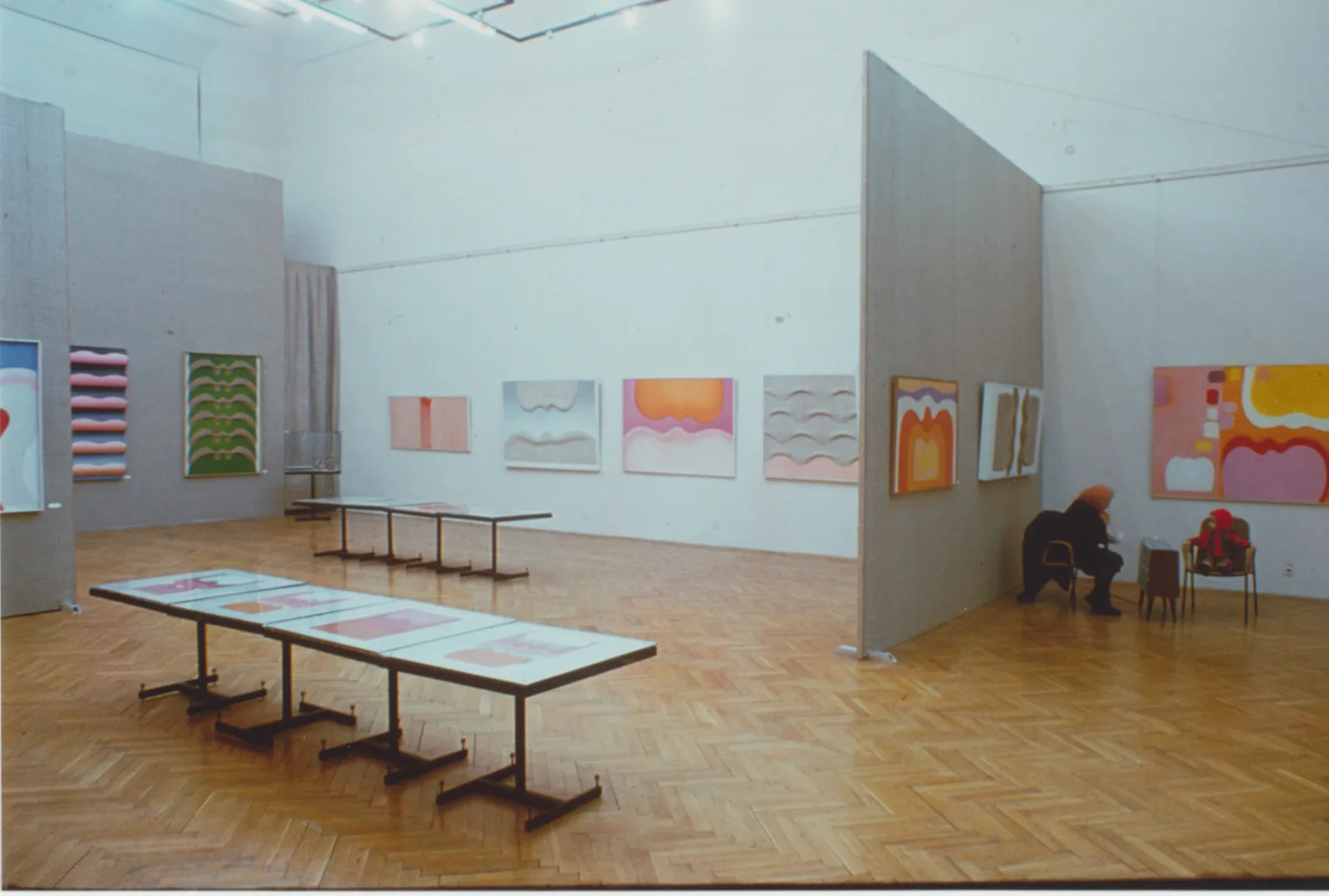
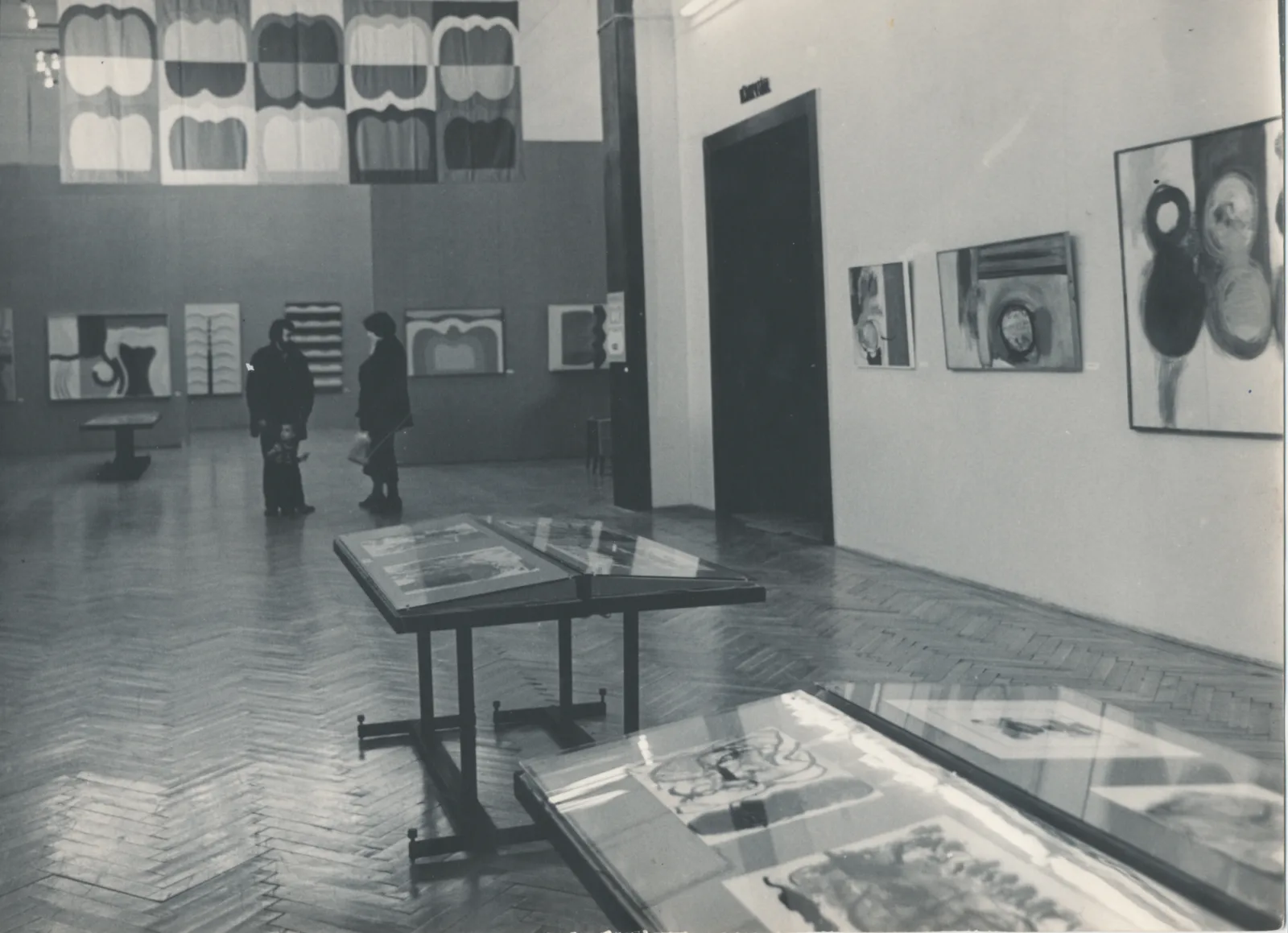


"Besides the painted signature motifs, we even get to meet ourselves in the mirror, behind all the colours. Then it is time to set off on a journey of discovery. We can observe how the arched, seamless lines evoke the colours of the rainbow, just as the neutral, seemingly monochrome edge of the mirror recalls the diversity of human skin colours."

Whilst Keserü initially gained recognition as a painter, from the mid-1960s the Hungarian artist had begun to experiment with diverse media. ‘Cylinder Robe’ was sewn from the striped fabric that originally composed ‘Colour Space (Happening at New Year’s Eve)’, exhibited at the College of Applied Arts in 1977. In its transformed state, the suspended structure featured in live performances at two of her exhibitions. Beginning with the series ‘Panneau Design’, 1978 the artist had begun what she termed ‘colour investigation’, aiming to show that “all the shades of the rainbow harmonise with any of the skin colours found on this earth.” In the years preceding, she had been occupied with theatre design: “I covered an entire stage with skin coloured canvas, which actors stirred around wearing costumes rendering all the colours of the rainbow.” As Péter Nádas has noted, whilst the study of colour formed a vital aspect of work by her contemporaries such as Victor Vasarely, László Moholy-Nagy, József Egry, and Tihamér Gyarmathy, Keserü incorporated a bodily, sensual quality which is unique to her practice.
‘Colour Column’ demonstrates her use of everyday objects to trigger associations, producing a sense of theatre and magic through vibrant pigment. Beginning with a traditional wooden stand, Keserü removed the arms from which coats and hats would have hung, polished it and applied a white base layer. She then painted the colour circle at its base, with each segment lengthening into stripes to the viewer's head height. Whilst Hungary’s covert 'neo-avant-garde’ of the 1960s and ‘70s is often considered in parallel to conceptual art in the West, Keserü’s work demonstrates the heterogynous nature of the nation’s art during this period. Discussing readymade objects such as ‘Colour Column’, Tandori Dezső highlights Keserü’s fusing of modernist visual languages. The artist “discovers that narrow, yet traversable pathway, which just as firmly separates its outcomes from pop art as it does from stylised new objectivity and from her only half-hearted period of minimal art, perhaps also from ornamentation, or from any distinguished urbanisation of folk art that can be twisted into clumsiness.”
"A faded film, shot in 1982 by Ilona Keserü’s husband László Vidovszky, captures Hungarian actress Nóra Németh moving theatrically around an exhibition space filled with Keserü’s colourful works. Her radiant 'Hengerpalást / Cylinder Robe' (1978) is slowly lowered by way of a simple pulley mechanism to reveal a woman, stepping out as though from a rainbow bath, baptised in colour. [...] The installation produces a remarkably spontaneous social situation, revealing or concealing anyone interested in playing the game and participating in the embodied experience of being caught up ‘in’ colour. Keserü presumably embraced the performativity of all this, staging the limitations of optical experience in the gallery setting and compensating spectators with a sculptural opportunity to delight in the intense psychological and physical effects of colour."

‘Vetés / Sowing’ is a striking example of Keserü's mature practice, fusing local tradition with modernist trends. The work is constructed using a traditional Hungarian petticoat known as a ‘bikla’. The pleated linen is set with glue, painted in green and stitched onto the canvas to evoke an agricultural landscape. ‘Craft’ has been traditionally coded as ‘feminine’, associated with the domestic chores of making, mending and artisanal skills. Keserü subverts such conflations with 'women’s work' by transforming the fabric through an abstract visual language.
This composition originated in the frequent train journeys that Keserü made between Budapest and Pécs. Gazing from the carriage windows at acres of freshly ploughed soil, she was inspired by the parallel which sprang to mind between the variously hued earth and different tones of human skin. The relief is part of a wider body of textiles that references farming communities and the role of women within them, revealing Keserü’s deep interest in Hungary's cultural history. "Organic and constructivist. Technical and folk artistic," as Péter Nádas has described her, Keserü employs traditional methods to invoke her lived experience as a woman artist whilst pushing beyond conventions of craft and femininity.
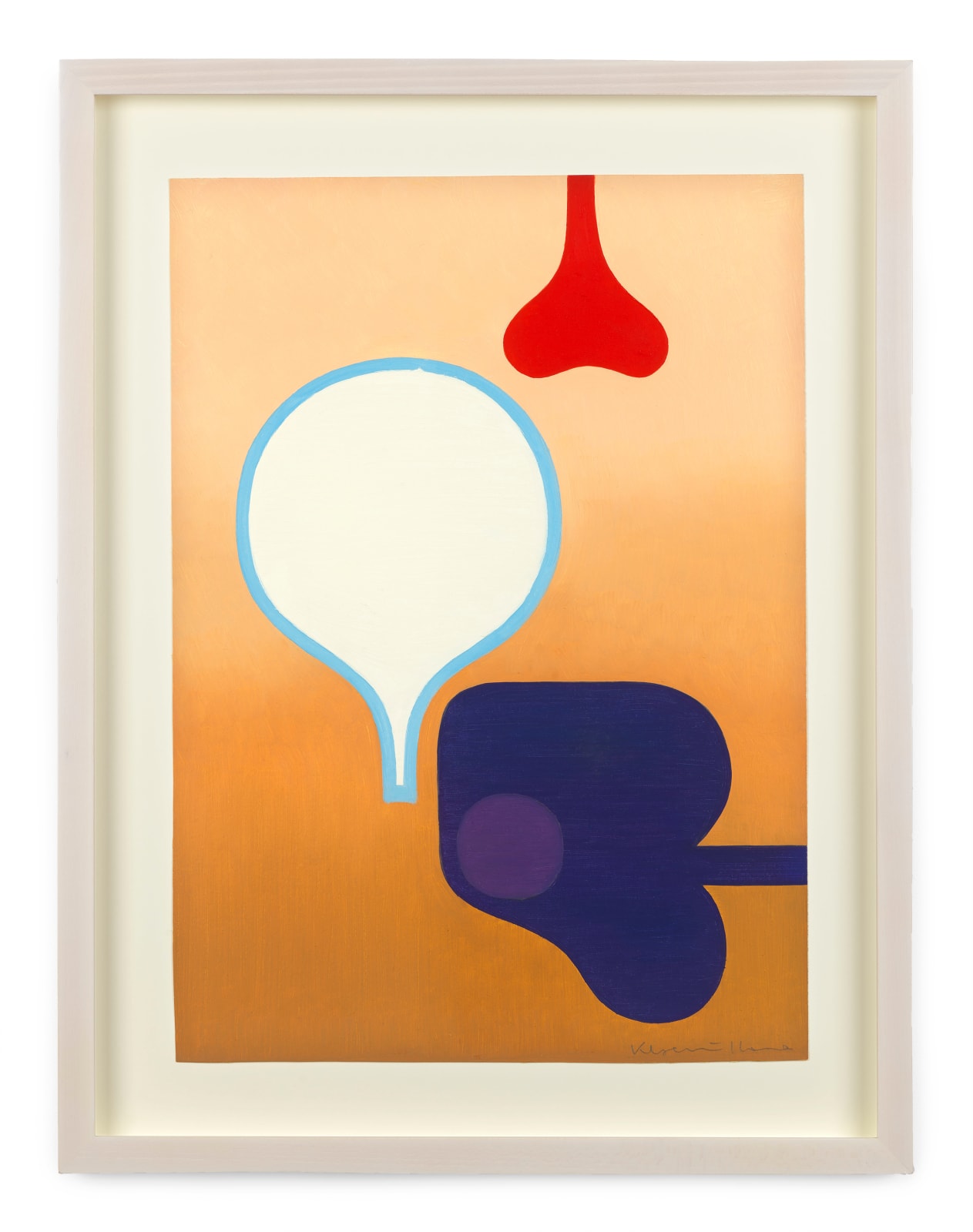
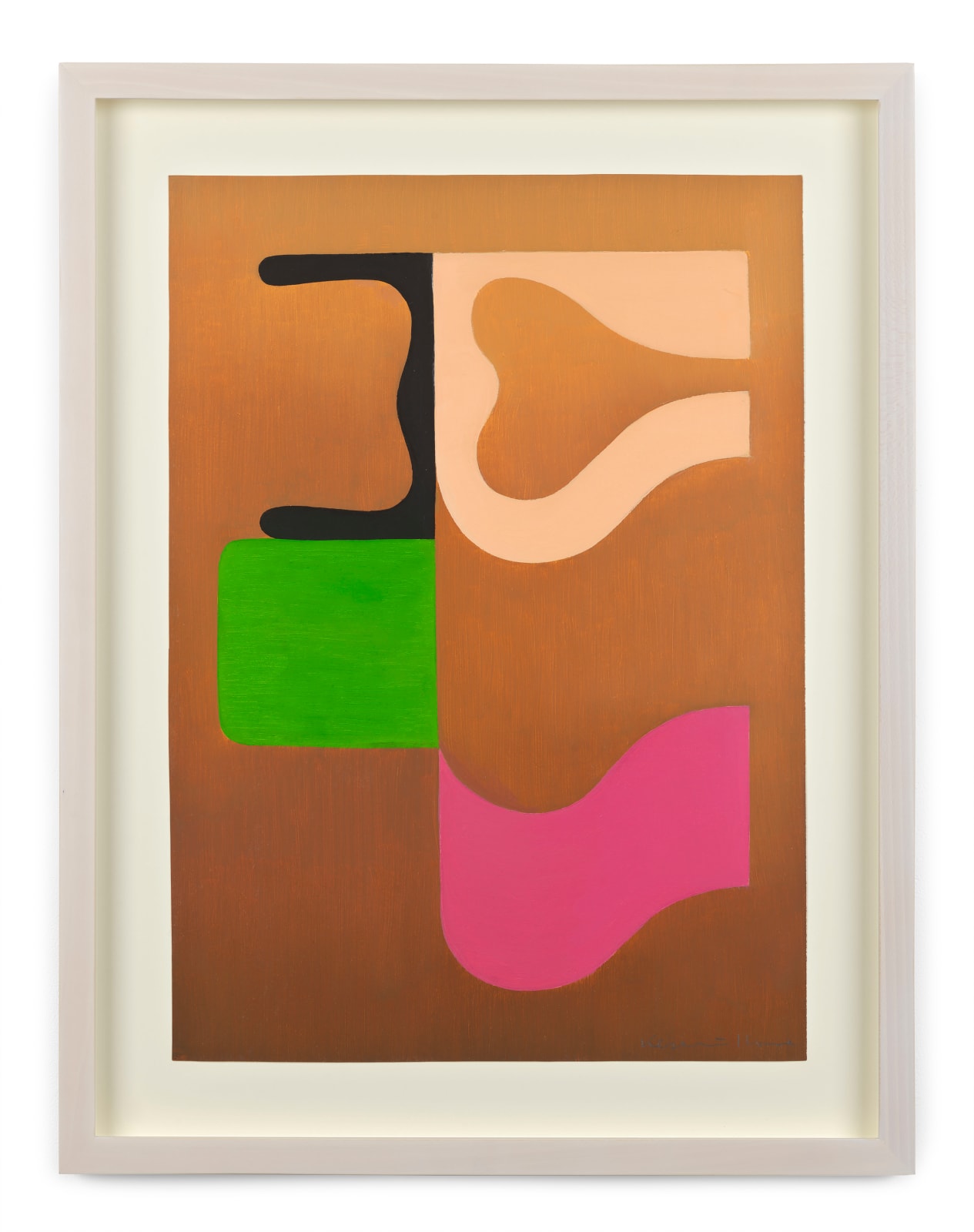
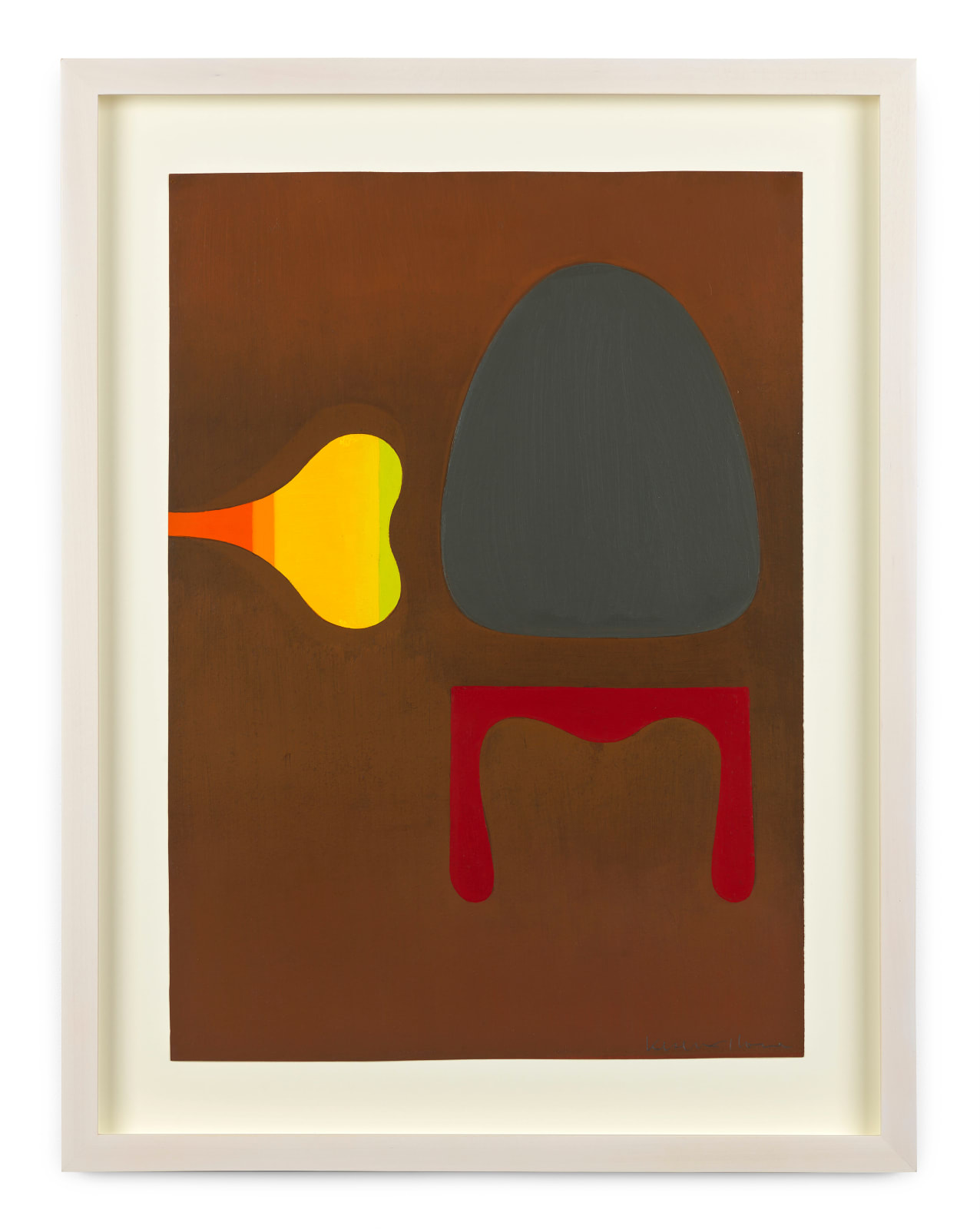
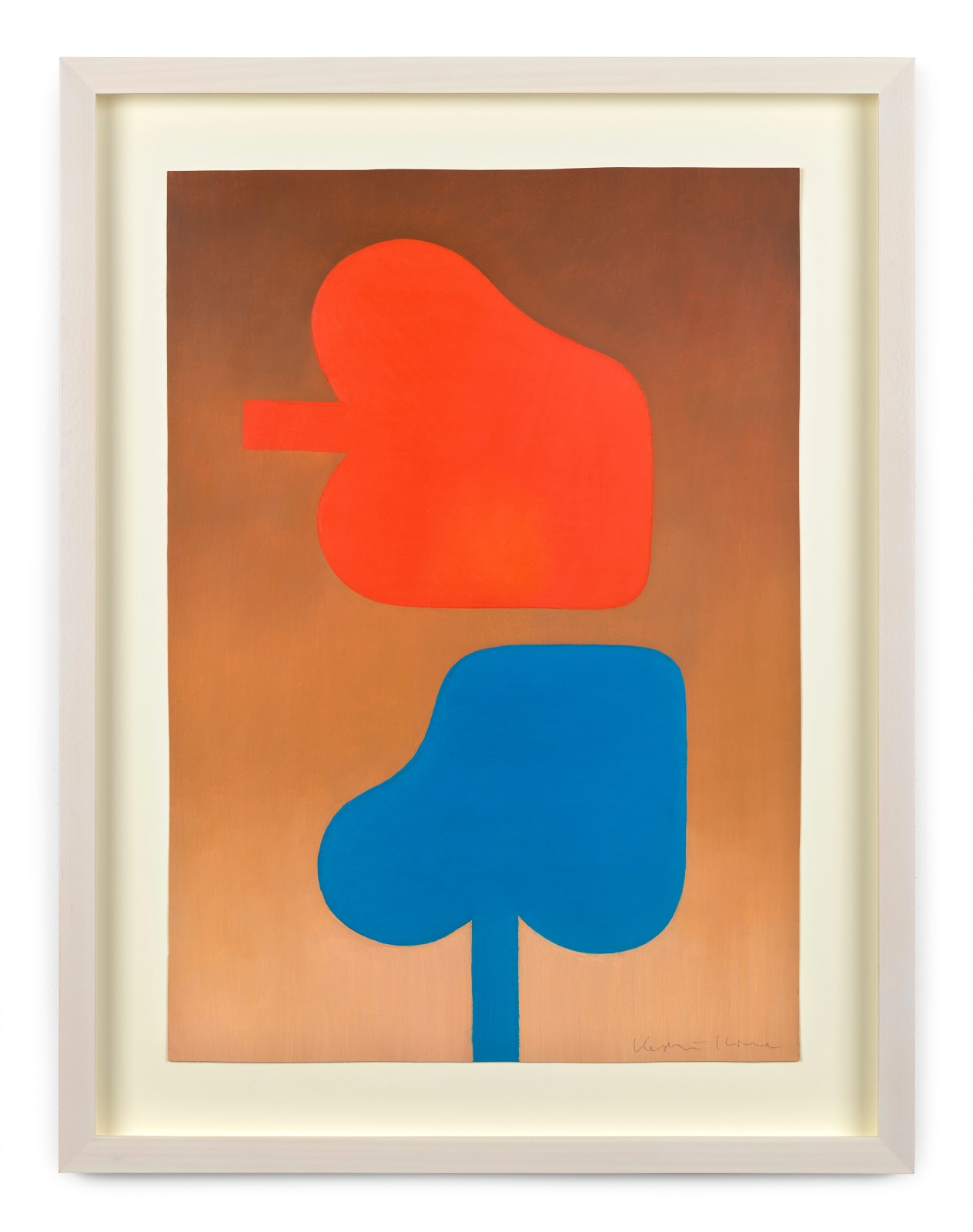
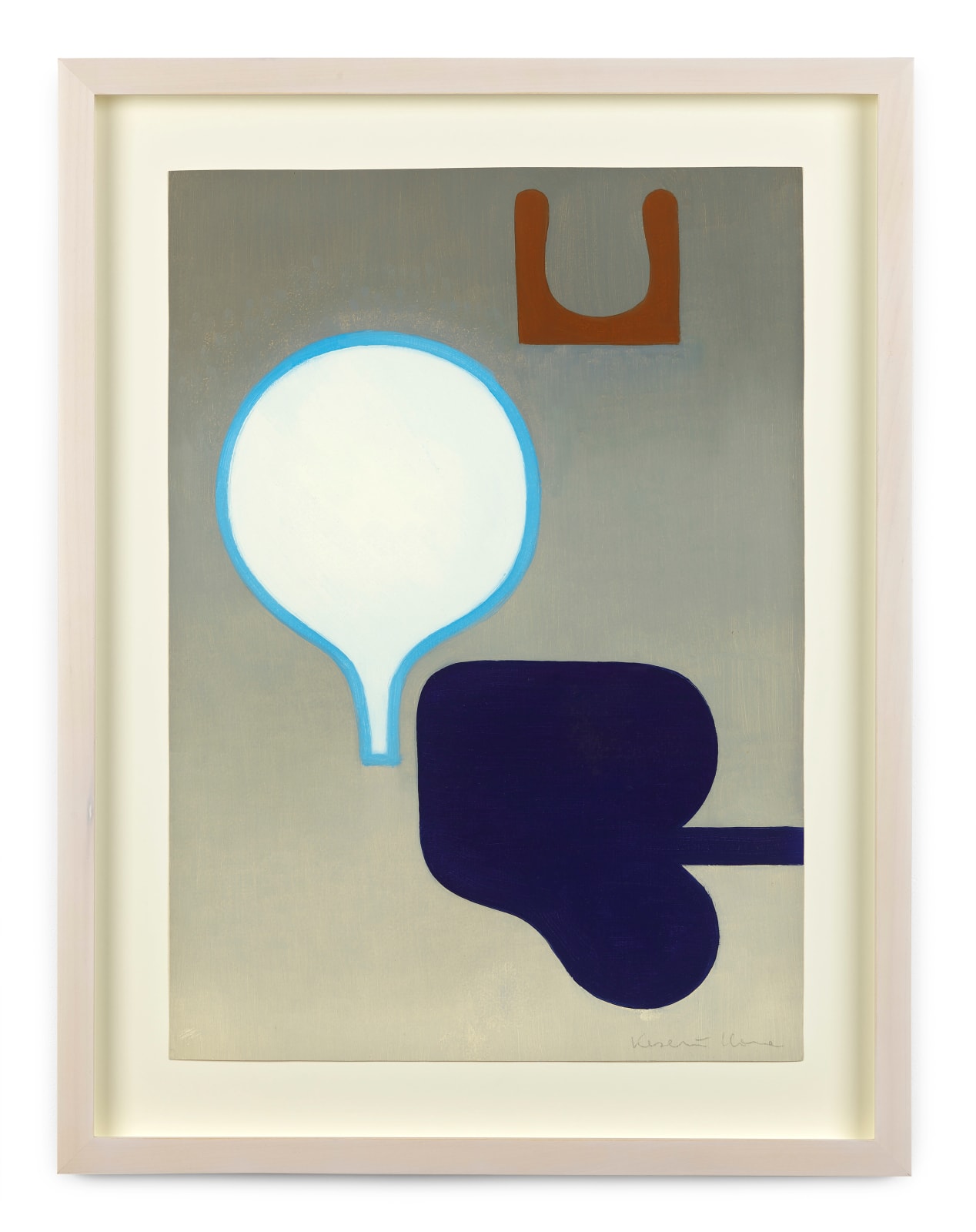

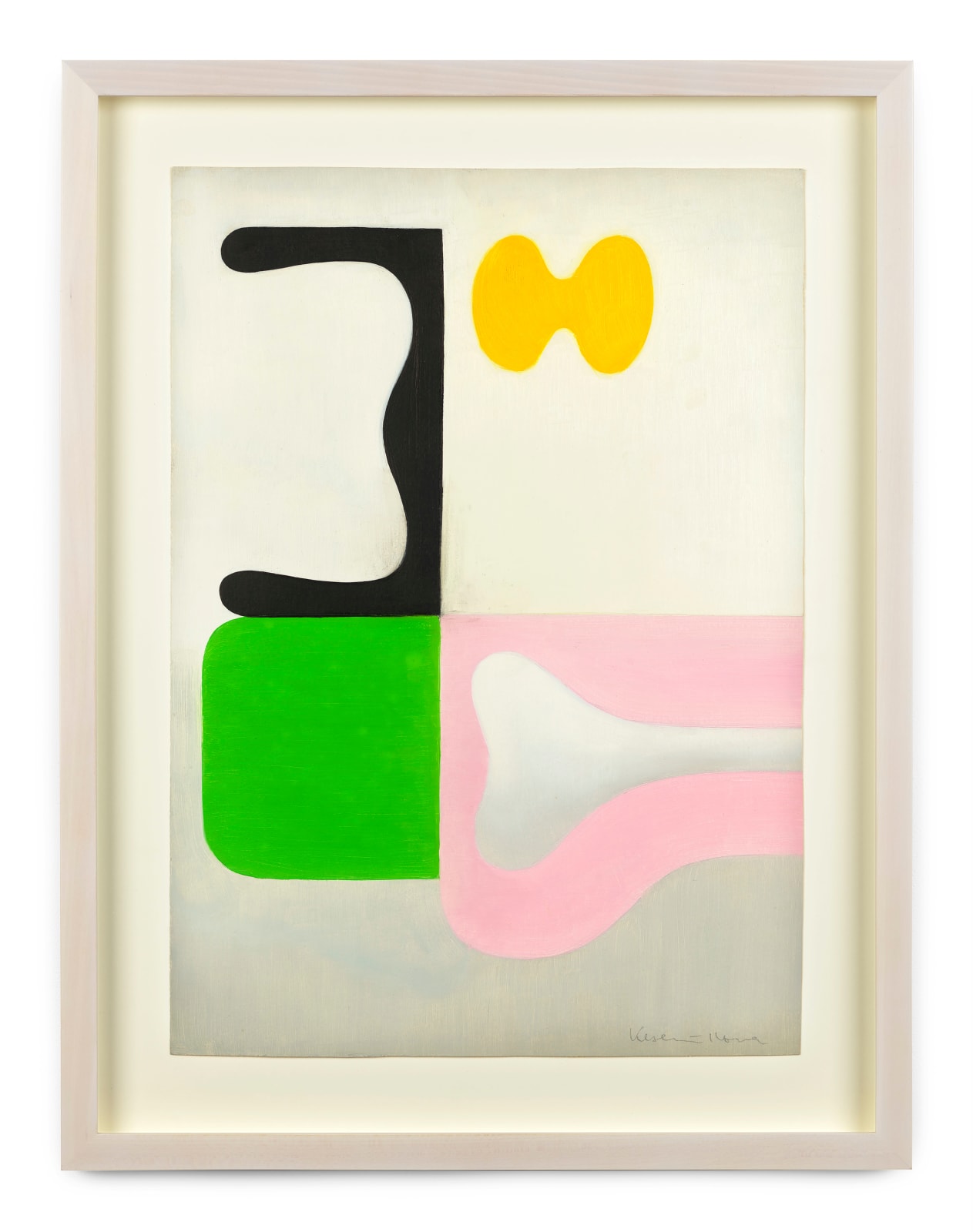

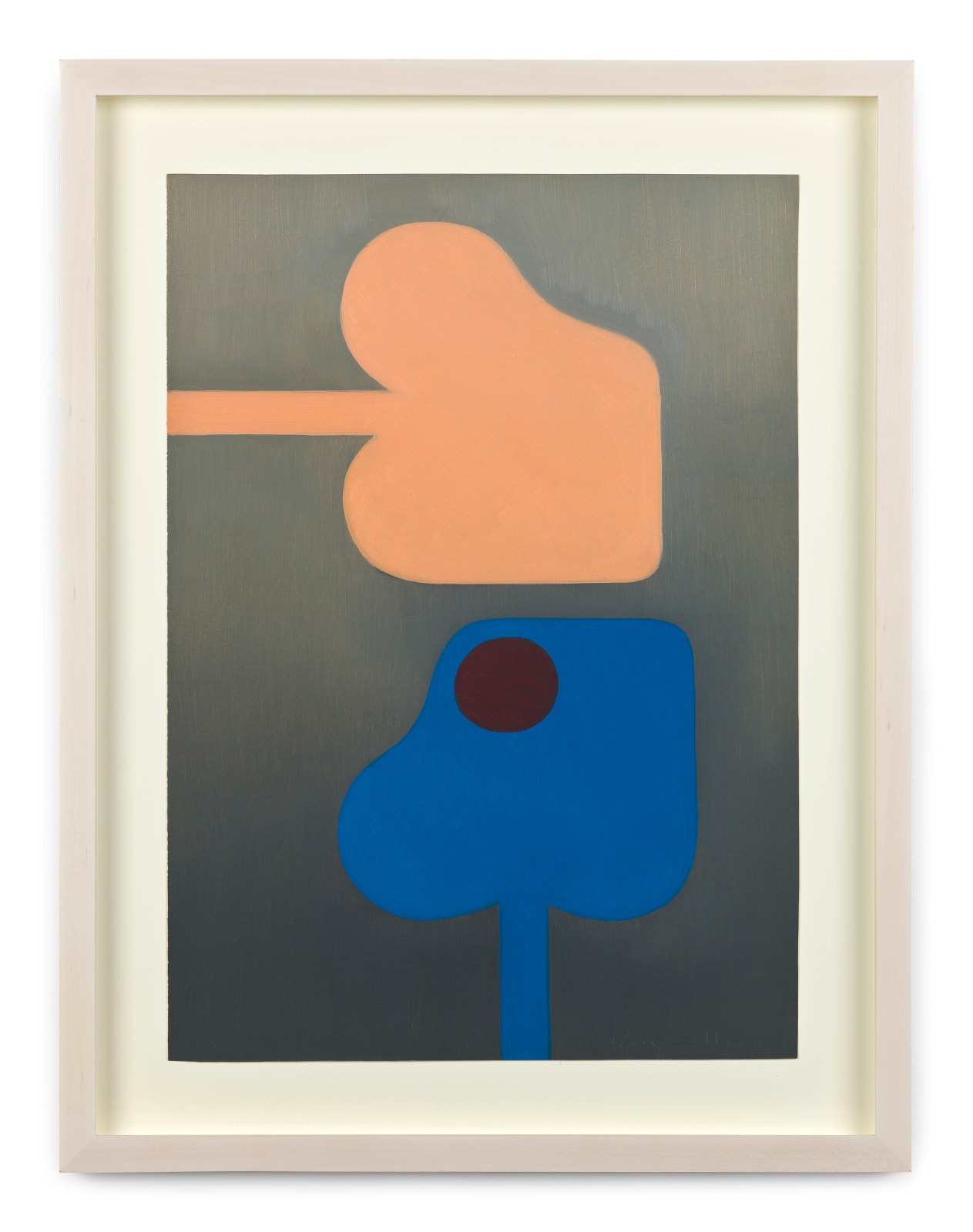

In her recent essay, Klara Kemp-Welch describes the way in which the anthropomorphic forms in Keserü's 'Pendant Object' series toy “with non-objectivity. While Suprematism sought to ‘liberate form’ and ‘escape from the circle of things’ – its white ground representing infinite cosmic space – the ground on which this odd assortment of figures floats is either grey-scale, or skin-tone-scale.” Challenging us to read them as both figurative and abstract, these works are intended as part of a larger conversation: “I am not avant-garde”, [Keserü] says. “what I care about is being part of the world context”.
The Pendant Object paintings were made by Ilona Keserü in 1981 at the Kamień Pomorski artists’ colony in Poland. The compositions derive from her eponymous body of textiles and were created with the intention of producing screenprints in Dresden – a project that was never realised. This work was made at a time in the People’s Republic of Poland when everyday life was severely restricted, shortly before the introduction of martial law in December 1981. In this tense political context Keserü withdrew and occupied herself with work, gesturing at freedom through a visual language that reaches towards the universal.
"One formal element connects Keserü’s various bodies of work, though: her predilection for curving shapes, specifically the repeated motif of an undulating line, a horizontal, sinusoidal ripple. [... C]orporeal associations are inevitable, given Keserü’s palette for these works: zingy, fleshy pinks; lipsticky reds and oranges. The sense is of playfully revelling in colour, of becoming immersed in its warmth. So it’s perhaps surprising to learn that her particular curvilinear motif originally derives from a cemetery in a village called Balatonudvari, in western Hungary, where the headstones are famously heart-shaped (though apple-shaped might be nearer the mark). Keserü’s line, then, is the curvature from the headstones’ top edge, and it functions as a way of linking modernist experimentation with older folk traditions – as well, presumably, as being intended as a sort of memento mori. Beyond their surface delights, beyond the pleasure principle of their fizzing colours, these works are meant to indicate some hidden, sepulchral truth, to hint at some unnerving fusion of Eros and Thanatos."
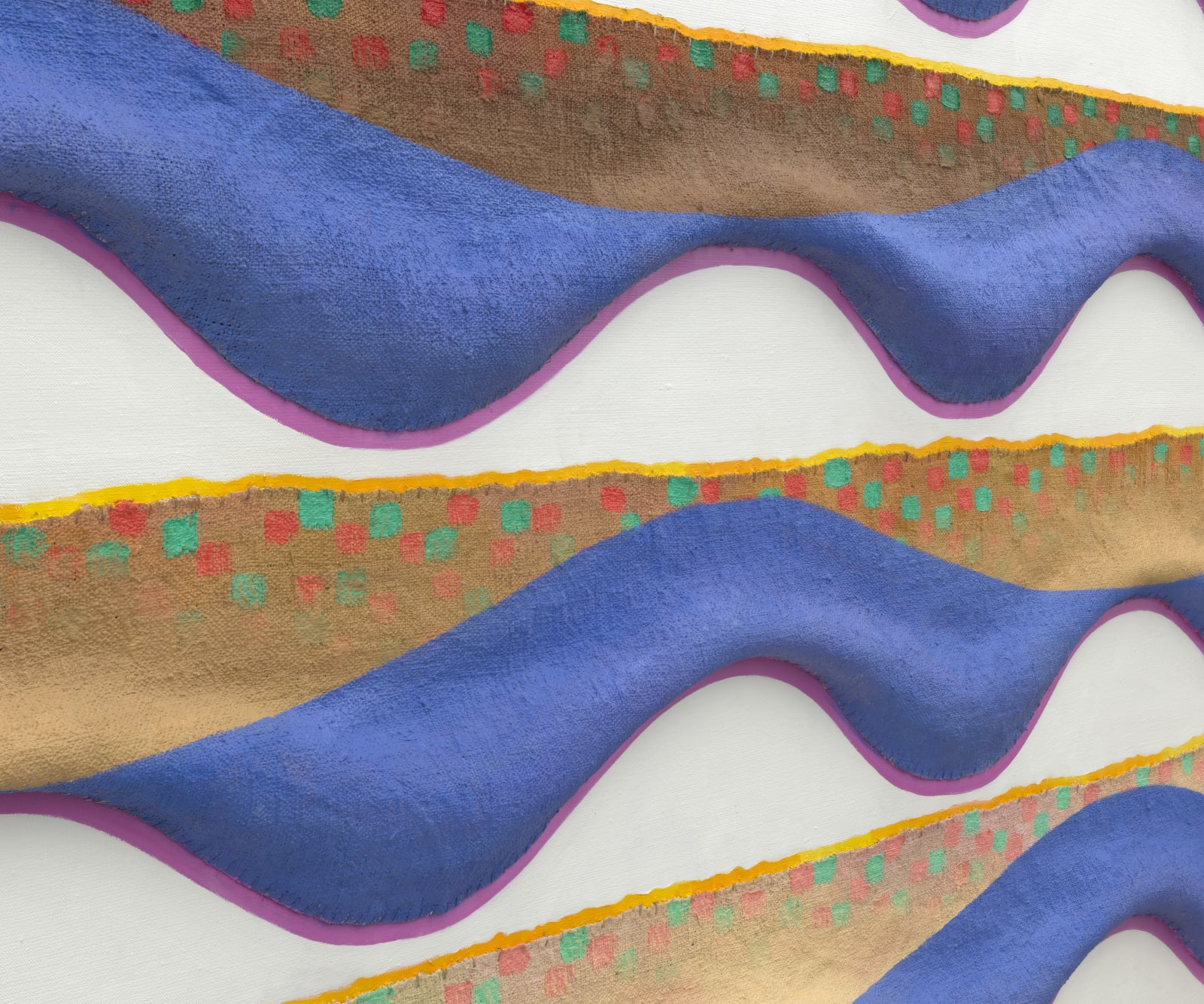
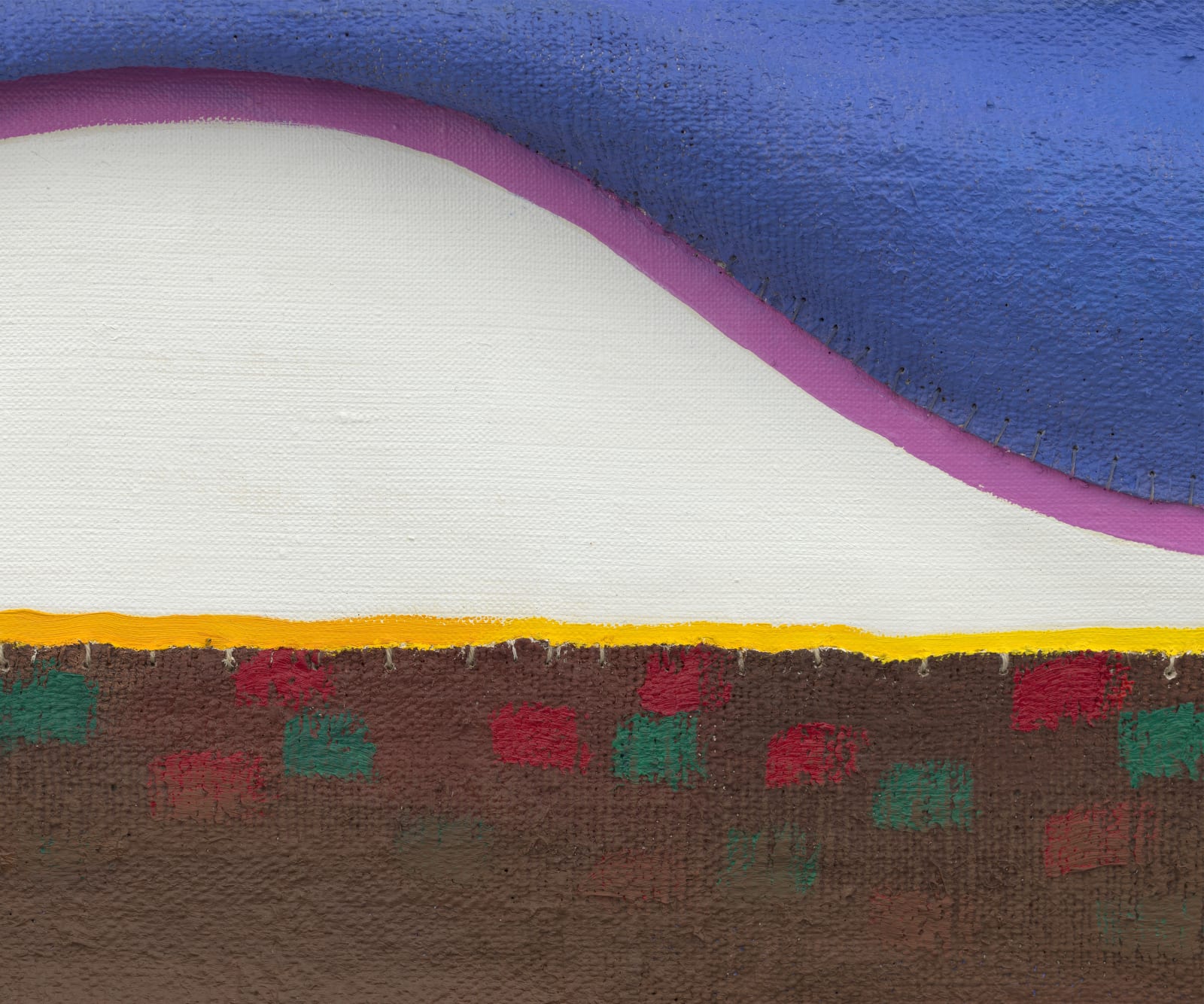

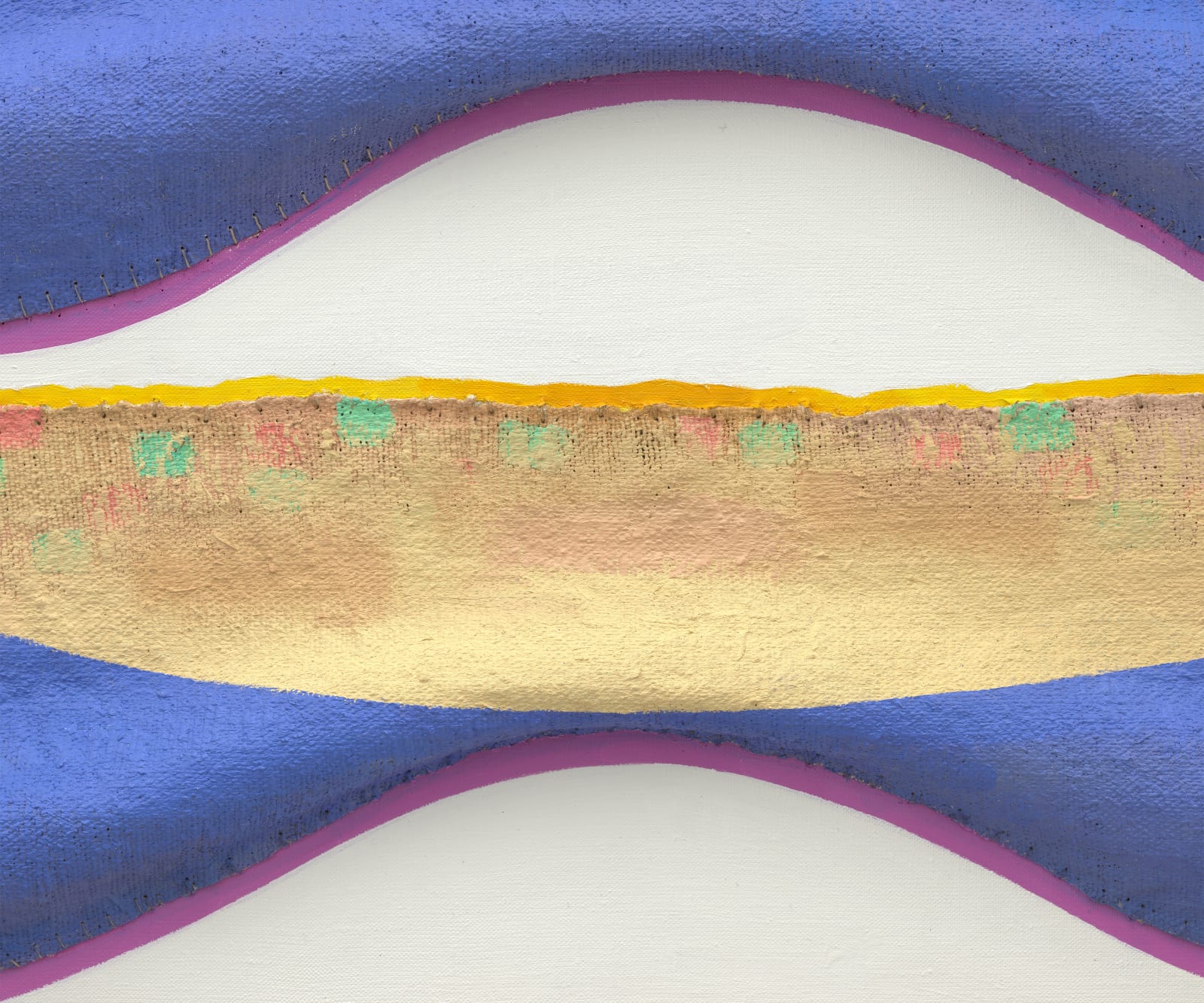

ILONA KESERÜ, b. 1933, Hungarian
In the face of political and cultural adversity, Keserü’s organic style of abstraction developed in defiance of Soviet rule following the Hungarian Revolution of 1956. From the age of 13 Keserü was taken under the wings of Ferenc Martyn, a painter of Irish origins, who had been a member of the Abstraction Creation group in Paris before moving to Pécs in the late 1940s.
In May 2021 the artist’s work was exhibited in the group show ‘Women in Abstraction’ at Centre Pompidou, Paris, France which travelled to Guggenheim Bilbao Museum, Bilbao, Spain in October 2021. The Metropolitan Museum of Art in New York included a monumental wall hanging by Keserü from their collection in the group show ‘Epic Abstraction: Pollock to Herrera’ in 2019. Stephen Friedman Gallery presented the artist’s first solo exhibition in London in 2018.
The second volume of Keserü’s catalogue raisonné was published in 2021, focusing on works made between 1981–2000. The third volume will be published later this year. Keserü's work features in the collections of numerous prominent institutions including Metropolitan Museum of Art; Ludwig Museum; Nationalgalerie; Ludwig Museum - Museum of Contemporary Art, Budapest, Hungary; Municipal Gallery - Kiscelli Museum, Budapest, Hungary; Francia Intézet, Budapest; Kassák Museum, Budapest, Hungary; Városi Művészeti Múzeum, Győr, Hungary; Modern Magyar Képtár II., Janus Pannonius Múzeum, Pécs, Hungary; National Museum of Modern Art, Seoul, South Korea; Szent István Király Múzeum, Székesfehérvár, Hungary; Ferenczy Múzeum, Szentendre; Fondation Károlyi, Vence, France; National Museum of Women in the Arts, Washington, USA and Zentralsparkasse und Kommerzialbank, Vienna, Austria.

